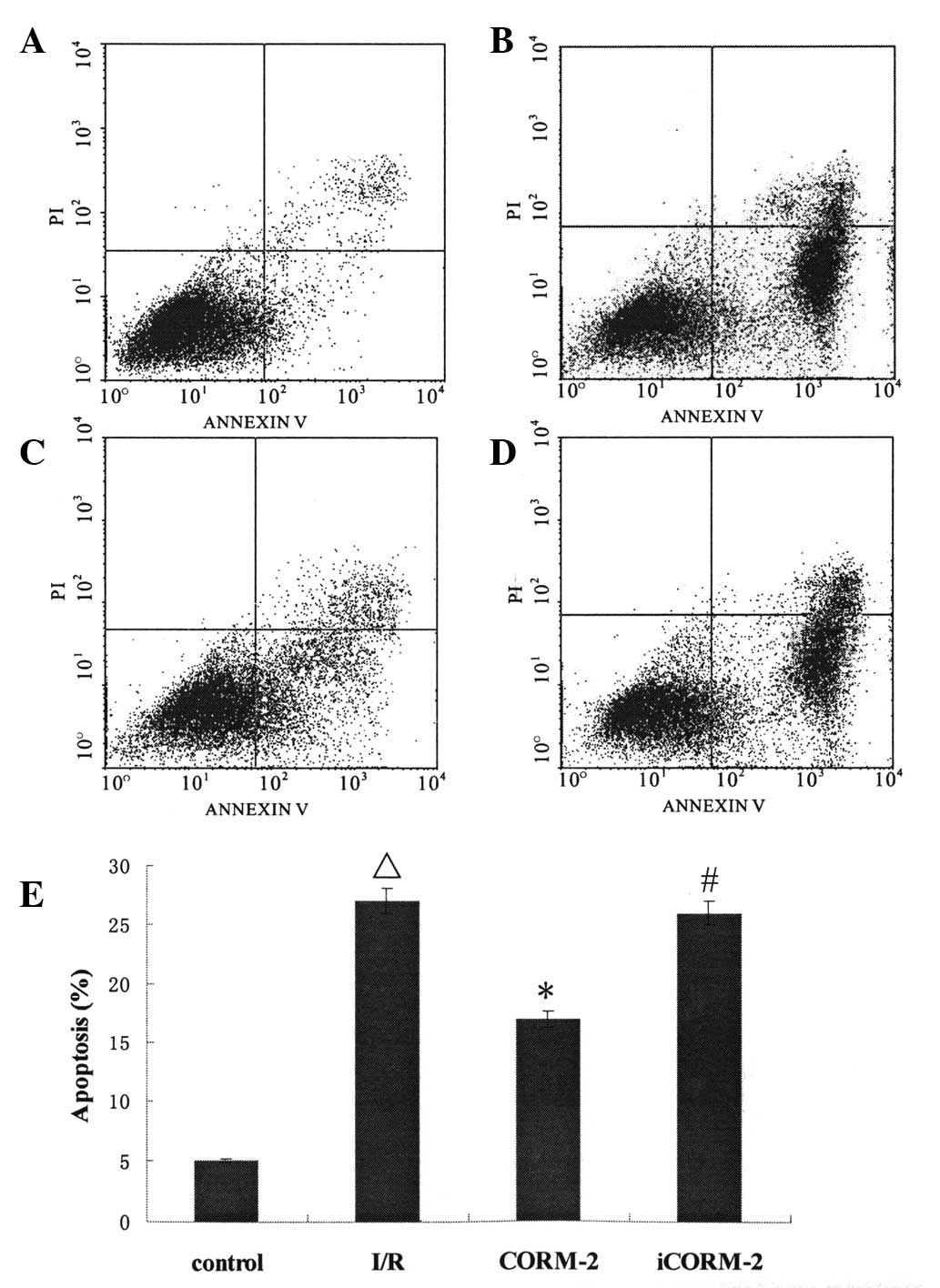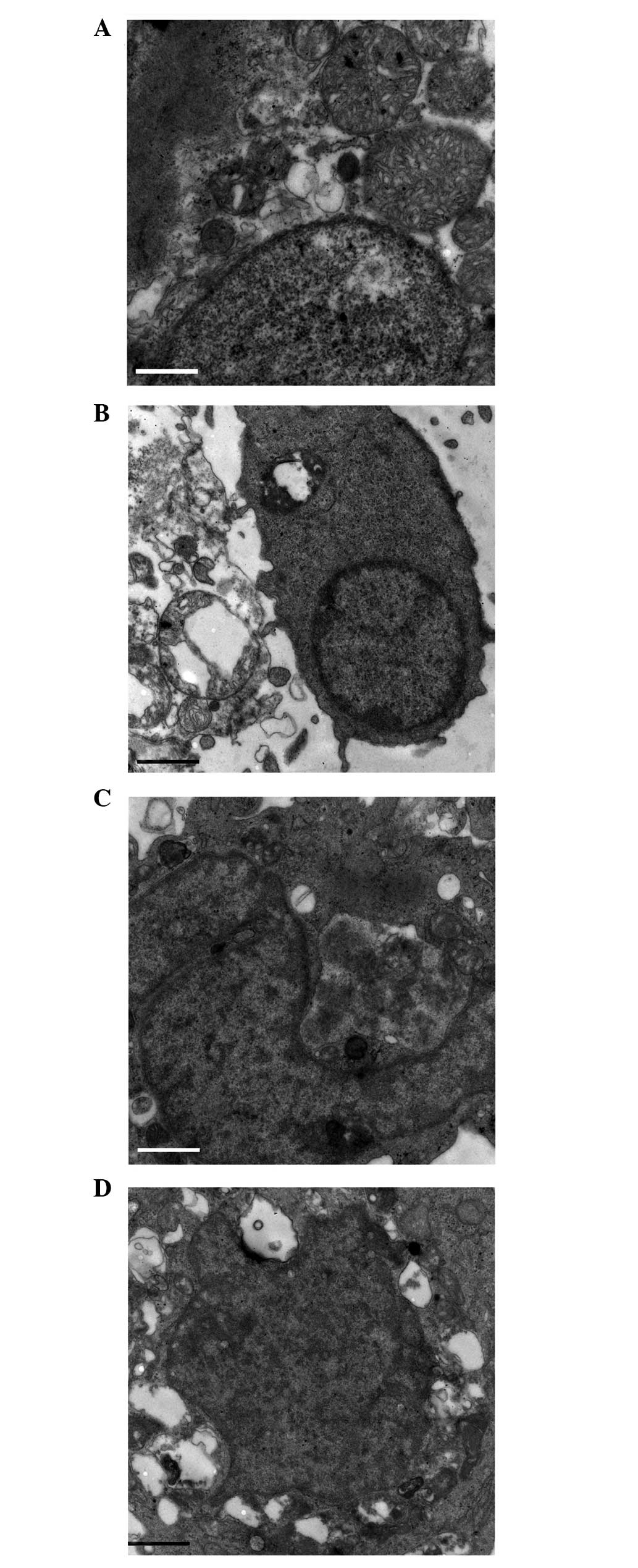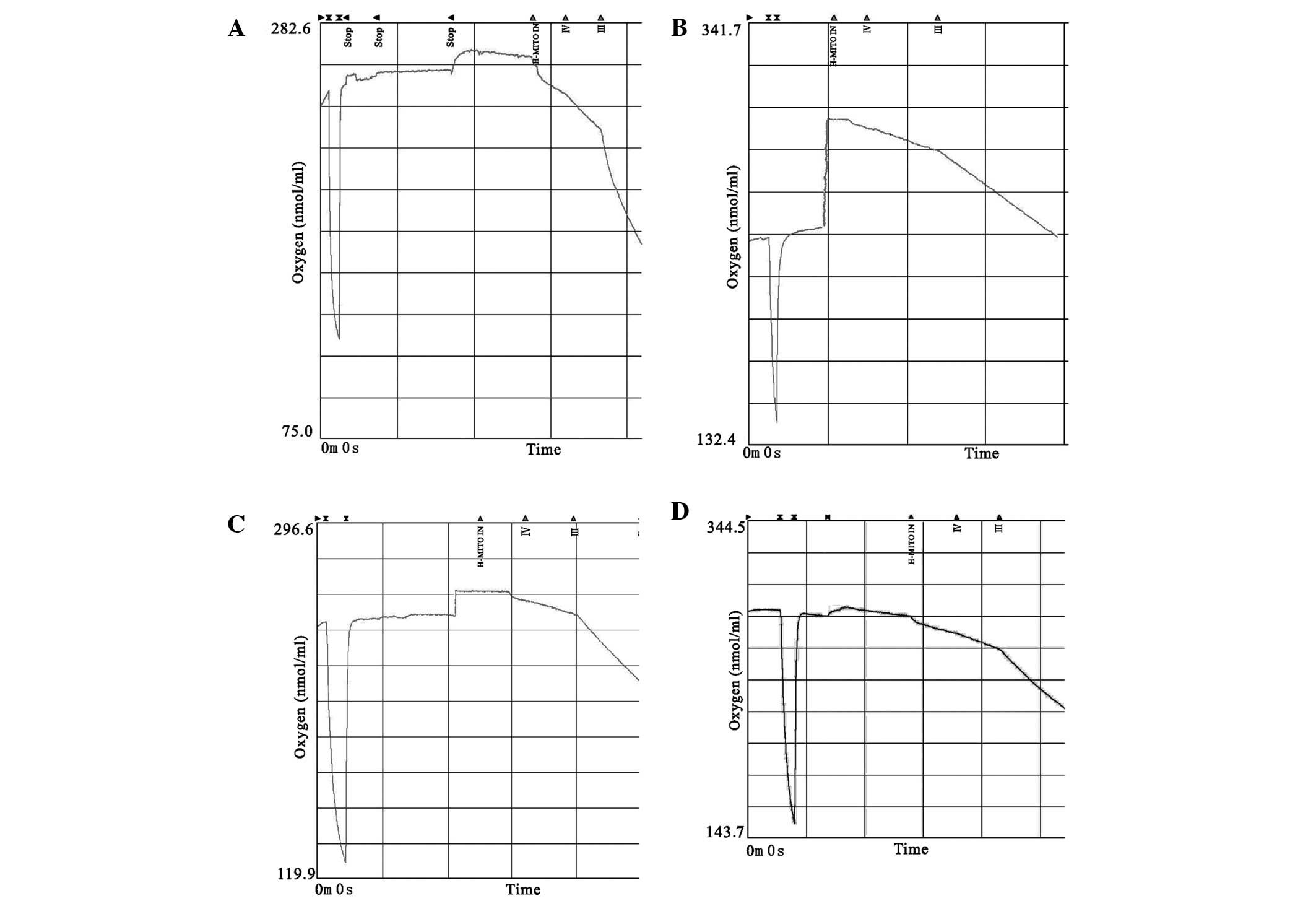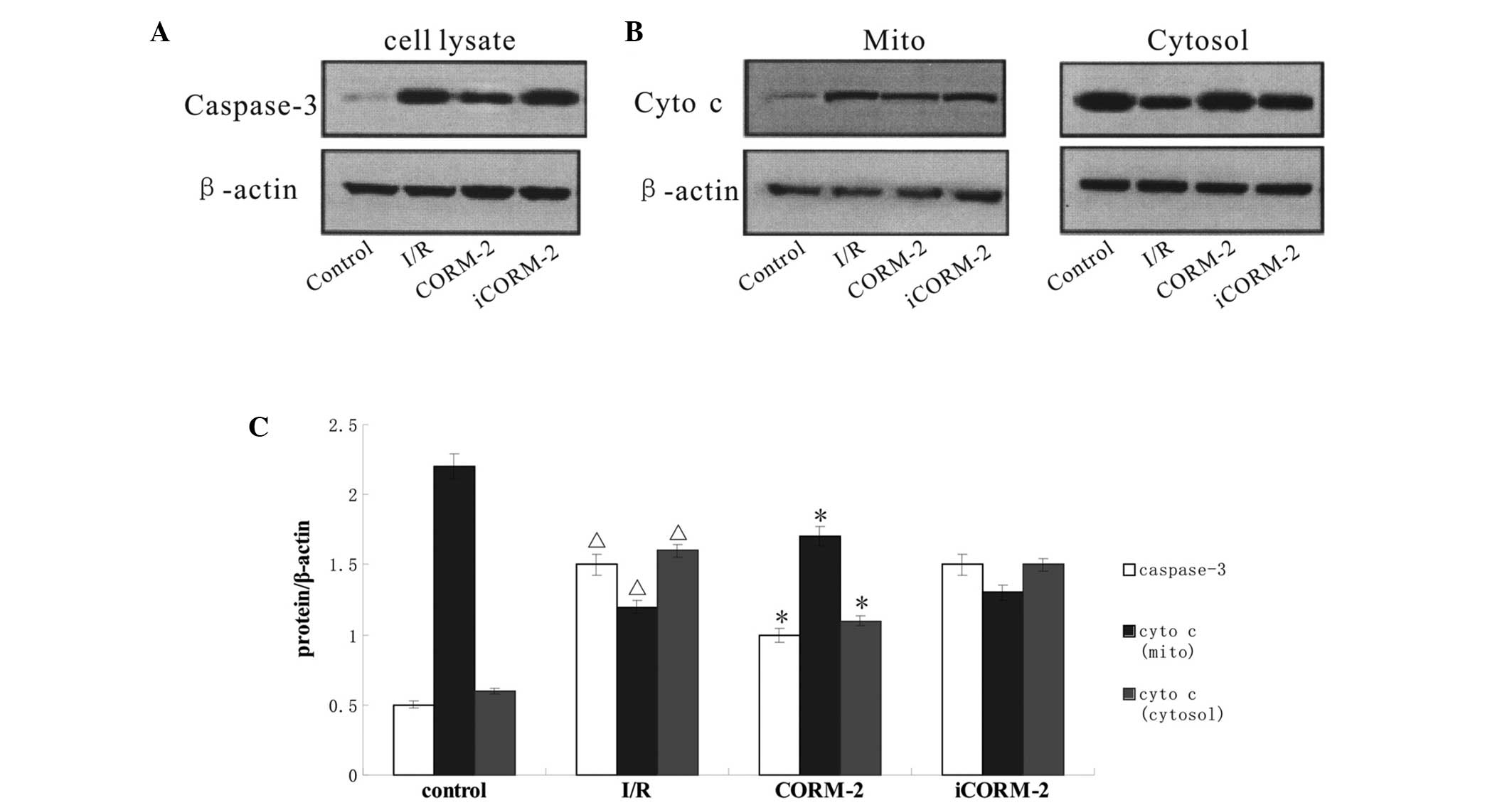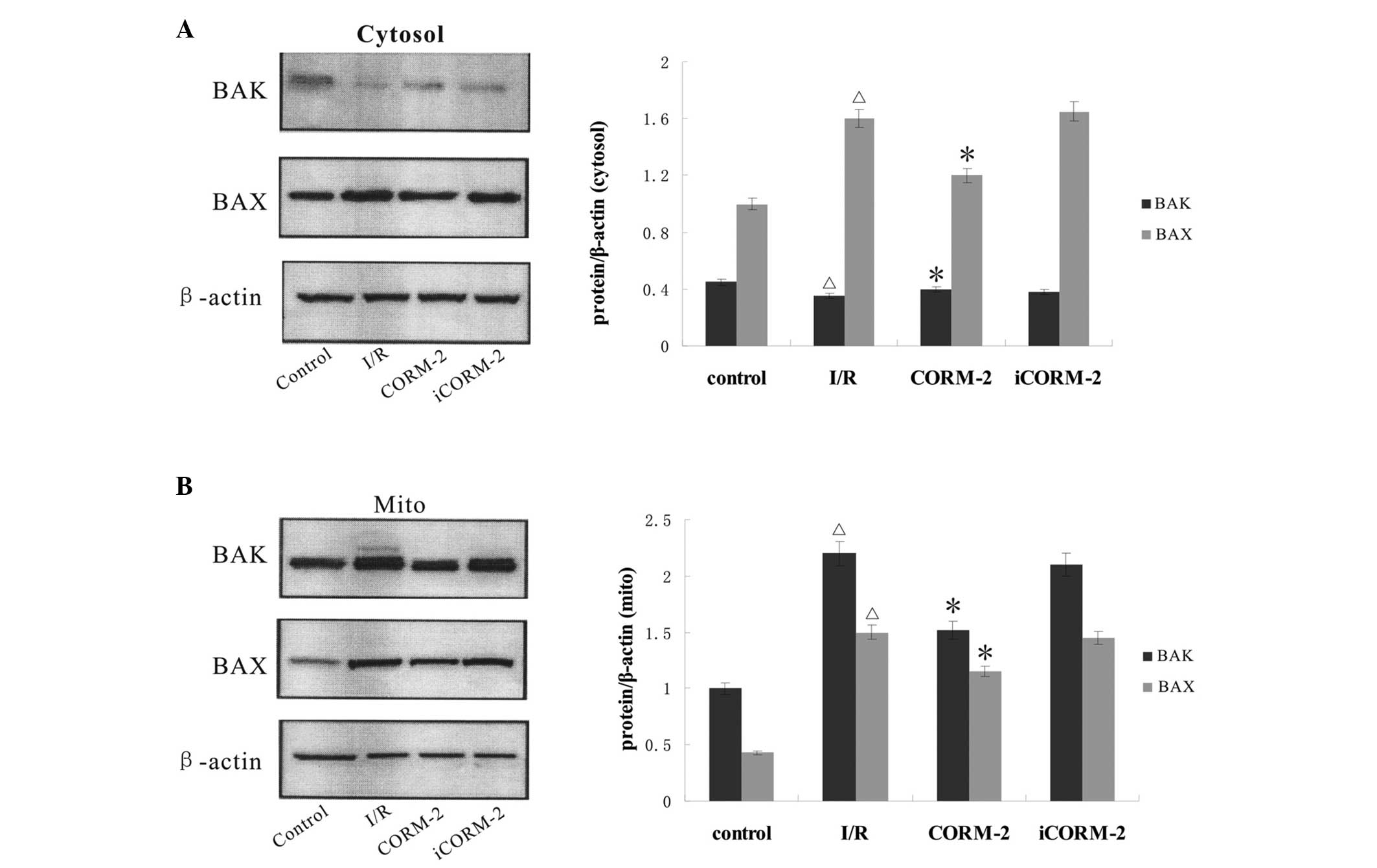|
1
|
Bialik S, Cryns VL, Drincic A, Miyata S,
Wollowick AL, Srinivasan A and Kitsis RN: The mitochondrial
apoptotic pathway is activated by serum and glucose deprivation in
cardiac myocytes. Circ Res. 85:403–414. 1999. View Article : Google Scholar : PubMed/NCBI
|
|
2
|
Radhakrishnan J, Wang S, Ayoub IM,
Kolarova JD, Levine RF and Gazmuri RJ: Circulating levels of
cytochrome c after resuscitation from cardiac arrest: a
marker of mitochondrial injury and predictor of survival. Am J
Physiol Heart Circ Physiol. 292:H767–H775. 2007.PubMed/NCBI
|
|
3
|
Li H, Fang X, Yang Z, et al: Ischemia
hypothermia improved contractility under normothermia reperfusion
in the model of cultured cardiomyocyte. In Vitro Cell Dev Biol
Anim. 48:284–292. 2012. View Article : Google Scholar : PubMed/NCBI
|
|
4
|
Di Lisa F, Canton M, Menabò R, Kaludercic
N and Bernardi P: Mitochondria and cardioprotection. Heart Fail
Rev. 12:249–260. 2007.
|
|
5
|
Danial NN and Korsmeyer SJ: Cell death:
critical control points. Cell. 116:205–219. 2004. View Article : Google Scholar : PubMed/NCBI
|
|
6
|
Chipuk JE and Green DR: How do BCL-2
proteins induce mitochondrial outer membrane permeabilization?
Trends Cell Biol. 18:157–164. 2008. View Article : Google Scholar : PubMed/NCBI
|
|
7
|
Kubli DA, Ycaza JE and Gustafsson AB:
Bnip3 mediates mitochondrial dysfunction and cell death through Bax
and Bak. Biochem J. 405:407–415. 2007. View Article : Google Scholar : PubMed/NCBI
|
|
8
|
Ren D, Tu HC, Kim H, et al: BID, BIM, and
PUMA are essential for activation of the BAX- and BAK-dependent
cell death program. Science. 330:1390–1393. 2010. View Article : Google Scholar : PubMed/NCBI
|
|
9
|
Roy SS, Ehrlich AM, Craigen WJ and
Hajnóczky G: VDAC2 is required for truncated BID-induced
mitochondrial apoptosis by recruiting BAK to the mitochondria. EMBO
Rep. 10:1341–1347. 2009. View Article : Google Scholar : PubMed/NCBI
|
|
10
|
Motterlini R and Otterbein LE: The
therapeutic potential of carbon monoxide. Nat Rev Drug Discov.
9:728–743. 2010. View
Article : Google Scholar : PubMed/NCBI
|
|
11
|
Queiroga CS, Almeida AS and Vieira HL:
Carbon monoxide targeting mitochondria. Biochem Res Int.
2012:7498452012. View Article : Google Scholar : PubMed/NCBI
|
|
12
|
Almeida AS, Queiroga CS, Sousa MF, Alves
PM and Vieira HL: Carbon monoxide modulates apoptosis by
reinforcing oxidative metabolism in astrocytes: role of Bcl-2. J
Biol Chem. 287:10761–10770. 2012. View Article : Google Scholar : PubMed/NCBI
|
|
13
|
Conde de la Rosa L, Vrenken TE, Hannivoort
RA, et al: Carbon monoxide blocks oxidative stress-induced
hepatocyte apoptosis via inhibition of the p54 JNK isoform. Free
Radic Biol Med. 44:1323–1333. 2008.PubMed/NCBI
|
|
14
|
Bannenberg GL and Vieira HL: Therapeutic
applications of the gaseous mediators carbon monoxide and hydrogen
sulfide. Expert Opin Ther Pat. 19:663–682. 2009. View Article : Google Scholar : PubMed/NCBI
|
|
15
|
Motterlini R: Carbon monoxide-releasing
molecules (CO-RMs): vasodilatory, anti-ischaemic and
anti-inflammatory activities. Biochem Soc Trans. 35:1142–1146.
2007. View Article : Google Scholar : PubMed/NCBI
|
|
16
|
Katada K, Bihari A, Mizuguchi S, et al:
Carbon monoxide liberated from CO-releasing molecule (CORM-2)
attenuates ischemia/reperfusion (I/R)-induced inflammation in the
small intestine. Inflammation. 33:92–100. 2010. View Article : Google Scholar
|
|
17
|
Caumartin Y, Stephen J, Deng JP, et al:
Carbon monoxide-releasing molecules protect against
ischemia-reperfusion injury during kidney transplantation. Kidney
Int. 79:1080–1089. 2011. View Article : Google Scholar
|
|
18
|
Gomez LA, Alekseev AE, Aleksandrova LA,
Brady PA and Terzic A: Use of the MTT assay in adult ventricular
cardiomyocytes to assess viability: effects of adenosine and
potassium on cellular survival. J Mol Cell Cardiol. 29:1255–1266.
1997. View Article : Google Scholar : PubMed/NCBI
|
|
19
|
Cheng EH, Sheiko TV, Fisher JK, Craigen WJ
and Korsmeyer SJ: VDAC2 inhibits BAK activation and mitochondrial
apoptosis. Science. 301:513–517. 2003. View Article : Google Scholar : PubMed/NCBI
|
|
20
|
Ren D, Kim H, Tu HC, et al: The VDAC2-BAK
rheostat controls thymocyte survival. Sci Signal.
2:ra482009.PubMed/NCBI
|
|
21
|
Wei MC, Zong WX, Cheng EH, et al:
Proapoptotic BAX and BAK: a requisite gateway to mitochondrial
dysfunction and death. Science. 292:727–730. 2001. View Article : Google Scholar : PubMed/NCBI
|
|
22
|
Wei MC, Lindsten T, Mootha VK, et al:
tBID, a membrane-targeted death ligand, oligomerizes BAK to release
cytochrome c. Genes Dev. 14:2060–2071. 2000.PubMed/NCBI
|
|
23
|
Cheng EH, Wei MC, Weiler S, Flavell RA,
Mak TW, Lindsten T and Korsmeyer SJ: BCL-2, BCL-X(L) sequester BH3
domain-only molecules preventing BAX- and BAK-mediated
mitochondrial apoptosis. Mol Cell. 8:705–711. 2001. View Article : Google Scholar : PubMed/NCBI
|
|
24
|
Kim H, Rafiuddin-Shah M, Tu HC, Jeffers
JR, Zambetti GP, Hsieh JJ and Cheng EH: Hierarchical regulation of
mitochondrion-dependent apoptosis by BCL-2 subfamilies. Nat Cell
Biol. 8:1348–1358. 2006. View
Article : Google Scholar : PubMed/NCBI
|
|
25
|
Karbowski M, Norris KL, Cleland MM, Jeong
SY and Youle RJ: Role of Bax and Bak in mitochondrial
morphogenesis. Nature. 443:658–662. 2006. View Article : Google Scholar : PubMed/NCBI
|
|
26
|
Youle RJ and Strasser A: The BCL-2 protein
family: opposing activities that mediate cell death. Nat Rev Mol
Cell Biol. 9:47–59. 2008. View
Article : Google Scholar : PubMed/NCBI
|
|
27
|
Shoshan-Barmatz V, Keinan N and Zaid H:
Uncovering the role of VDAC in the regulation of cell life and
death. J Bioenerg Biomembr. 40:183–191. 2008. View Article : Google Scholar : PubMed/NCBI
|
|
28
|
Trumbeckaite S, Kincius M, Preidis A,
Preidiene M, Veikutis V, Borutaite V and Gulbinas A: Effects of
ischemia-reperfusion and pretreatment with mildronate on rat liver
mitochondrial function. Pharmacol Rep. 61:859–869. 2009. View Article : Google Scholar : PubMed/NCBI
|
|
29
|
Venditti P, Masullo P and Di Meo S:
Effects of myocardial ischemia and reperfusion on mitochondrial
function and susceptibility to oxidative stress. Cell Mol Life Sci.
58:1528–1537. 2001. View Article : Google Scholar : PubMed/NCBI
|
|
30
|
Chen Q, Moghaddas S, Hoppel CL and
Lesnefsky EJ: Reversible blockade of electron transport during
ischemia protects mitochondria and decreases myocardial injury
following reperfusion. J Pharmacol Exp Ther. 319:1405–1412. 2006.
View Article : Google Scholar : PubMed/NCBI
|
|
31
|
Elimadi A, Settaf A, Morin D, Sapena R,
Lamchouri F, Cherrah Y and Tillement JP: Trimetazidine counteracts
the hepatic injury associated with ischemia-reperfusion by
preserving mitochondrial function. J Pharmacol Exp Ther. 286:23–28.
1998.PubMed/NCBI
|
|
32
|
Clark JE, Naughton P, Shurey S, et al:
Cardioprotective actions by a water-soluble carbon
monoxide-releasing molecule. Circ Res. 93:e2–e8. 2003. View Article : Google Scholar : PubMed/NCBI
|
|
33
|
Zhang X, Shan P, Alam J, Davis RJ, Flavell
RA and Lee PJ: Carbon monoxide modulates Fas/Fas ligand, caspases,
and Bcl-2 family proteins via the p38alpha mitogen-activated
protein kinase pathway during ischemia-reperfusion lung injury. J
Biol Chem. 278:22061–22070. 2003. View Article : Google Scholar
|
|
34
|
Sandouka A, Fuller BJ, Mann BE, Green CJ,
Foresti R and Motterlini R: Treatment with CO-RMs during cold
storage improves renal function at reperfusion. Kidney Int.
69:239–247. 2006. View Article : Google Scholar : PubMed/NCBI
|
|
35
|
Lo Iacono L, Boczkowski J, Zini R,
Salouage I, Berdeaux A, Motterlini R and Morin D: A carbon
monoxide-releasing molecule (CORM-3) uncouples mitochondrial
respiration and modulates the production of reactive oxygen
species. Free Radic Biol Med. 50:1556–1564. 2011.PubMed/NCBI
|



